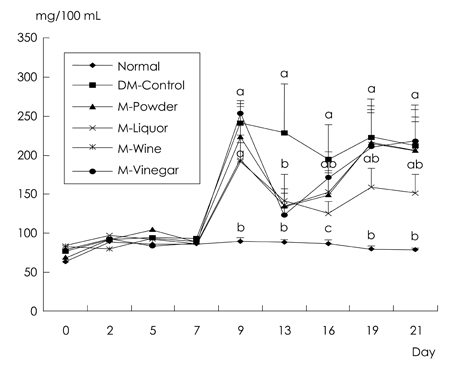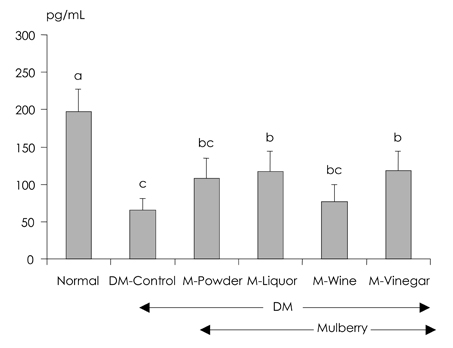Korean J Nutr.
2010 Dec;43(6):551-560. 10.4163/kjn.2010.43.6.551.
Effects of Various Mulberry Products on the Blood Glucose and Lipid Status of Streptozotocin-induced Diabetic Rats
- Affiliations
-
- 1Department of Food Science and Nutrition, Catholic University of Daegu, Daegu 712-702, Korea. shcho@cu.ac.kr
- KMID: 2268051
- DOI: http://doi.org/10.4163/kjn.2010.43.6.551
Abstract
- The study aim was to investigate the effects of three types of mulberry products on the blood glucose and lipid statuses and peroxidative state under diabetic condition. The three types were mulberry liquor prepared by adding 30% ethanol to the crushed fresh fruit, mulberry wine and vinegar by fermentation. For diet experiment the mulberry liquor (M-Liquor), wine (M-Wine), and vinegar (M-Vinegar) were prepared as powders by freeze-drying of the respective product and were added to the diet at the level of 1% and mulberry fruit powder (M-Powder) at the level of 5%. Sprague-Dawley female rats weighing 150 +/- 10 g were randomly assigned to one normal group, and five diabetic groups induced by one intraperitoneal injection of streptozotocin (STZ) at the level of 50 mg/kg. The normal and diabetic control (DM-Control) groups were fed diet without the mulberry products. During twenty-one days of experimental diet, blood glucose was maintained at a low level in the M-Liquor group compared with the DM-Control group. However, serum insulin level was higher in both M-Liquor and M-Vinegar groups after the experimental diet period. Serum levels of total cholesterol and triglyceride (TG) were lower in M-Liquor but HDL-/total cholesterol ratios were higher in the four M groups. The TG liver level was lower in M-Powder and M-Vinegar groups but the cholesterol level was lower in M-Powder than in the DM-Control group. Serum levels of thiobarbituric acid reactive substances were not different among the groups but the liver levels of these substances were lower in the four M groups than in DM-Control. Serum GOT and GPT levels were not changed by the mulberry products. These results indicated that mulberry liquor is the most effective among the four mulberry products for normalizing blood glucose and lipid status and that all the mulberry products were effective in enhancing antioxidant defense in the diabetic state.
Keyword
MeSH Terms
-
Acetic Acid
Animals
Blood Glucose
Cholesterol
Diet
Ethanol
Female
Fermentation
Fruit
Humans
Injections, Intraperitoneal
Insulin
Liver
Morus
Powders
Rats
Streptozocin
Thiobarbiturates
Thiobarbituric Acid Reactive Substances
Wine
Acetic Acid
Blood Glucose
Cholesterol
Ethanol
Insulin
Powders
Streptozocin
Thiobarbiturates
Thiobarbituric Acid Reactive Substances
Figure
Cited by 1 articles
-
Effects of the purified extracts from Lycii Cortex Radicis and ginger on lipid statusand serum cytokine levels in rats fed high fat diet
Eun-Jung Park, Sang-Won Choi, Sung-Hee Cho
Korean J Nutr. 2012;45(5):411-419. doi: 10.4163/kjn.2012.45.5.411.
Reference
-
1. Kim SK. Beneficial medicine, mulberry fruit. Bonchohak. 1991. Seoul: Younglimsa;598–605.2. Kim AJ, Kim MW, Woo N, Kim SY, Kim HB, Lim YH, Kim MH. Study on the nutritional composition and antioxidative capacity of mulberry fruit (Ficus-4x). Korean J Food Sci Technol. 2004. 36(6):995–1000.3. Park SW, Jung YS, Ko KC. Quantitative analysis of anthocyanins among mulberry cultivars and their pharmacological screening. J Korean Soc Hort Sci. 1997. 38(6):722–724.4. Kim HB, Kim SL, Moon JY. Quantification and varietal variation of anthocyanin pigment in mulberry fruits. Korean J Breed. 2002. 34(3):207–211.5. Kim EO, Yu MW, Suh IH, Lee YJ, Im HH, Kang DH, Choi SW. Comparison of physiochemical properteis of seven different mulberry (Morus alba L.) cultivars. J Korean Soc Food Sci Nutr. 2010. 39(10):in press.6. Kim HB, Kim SL. Quantification and variation of rutin in mulberry fruits. Korean J Sericult Sci. 2004. 46(1):1–5.7. Cha WS, Shin HR, Park JH, Oh SL, Lee WY, Chun SS, Choo JW, Cho YJ. Antioxidant activity of phenol compounds from mulberrry fruits. Korean J Food Preserv. 2004. 11(3):383–387.8. Lee JY, Moon SO, Kwon YJ, Rhee SJ, Park HR, Choi SW. Identification and quantification of anthocyanins and flavonoids in mulberry (Morus sp.) cultivars. Food Sci Biotechnol. 2004. 13(2):176–184.9. Kwon YJ, Rhee SJ, Chu JW, Choi SW. Comparison of radical scavenging activity of extracts of mulberry juice and cake prepared from mulberry (Morus spp.) fruit. J Food Sci Nutr. 2005. 10(2):111–117.
Article10. Kim SY, Park KJ, Lee WC. Antiinflammatory and antioxidative effects of Morus spp fruit extract. Korean J Med Crop Sci. 1998. 6(3):204–209.11. Kim HJ, Cha JY, Choi ML, Cho YS. Antioxidative activities by water-soluble extracts of Morus alba and Cudrania tricuspidata. J Korean Soc Agric Chem Biotechnol. 2000. 43(2):148–152.12. Shin YW, Lee SK, Kwon YJ, Rhee SJ, Choi SW. Radical scavenging activity of phenolic compounds from mulberry (Morus spp.) cake. J Food Sci Nutr. 2005. 10(4):326–332.
Article13. Kwon EH, Jung MA, Rhee SJ, Choi SW, Cho SH. Antioxidant effects and improvement of lipid metabolism of mulberry fruit, mulberry leaves and silkworm powder with different mixing ratios in streptozotocin-induced diabetic rats. Korean J Nutr. 2006. 39(2):91–99.14. Kwon EH, Jang HS, Kim SW, Choi SW, Rhee SJ, Cho SH. Effects of mulberry juice and cake powder on blood glucose and lipid lowering and erythrocyte antioxidative enzyme activities in streptozotocin-induced diabetic rats. Korean J Nutr. 2007. 40(3):199–210.15. Kim HB, Kim SY, Lee HY, Kim SL, Kang SW. Protective effect against neuronal cell and inhibitory activity against bacteria of mulberry fruit extracts. Korean J Crop Sci. 2005. 50(S):220–223.16. Kim AJ, Kim HB, Bang IS, Kim SY. The effects of mulberry fruit extract supplementation on the serum mineral contents and oxidative stress markers of middle-aged humans living in Choongnam area. Korean J Food Sci Technol. 2006. 38(2):284–289.17. Kim TY, Kwon YB, Lee JH, Yang IS, Youm JK, Lee HS, Moon JY. A study on the antidiabetic effect of mulberry fruits. Korean J Sericult Sci. 1996. 38(2):100–107.18. Kim HB, Kim SY, Ryu KS, Lee WC, Moon JY. Effect of methnol extract from mulberry fruit on the lipid metabolism and liver function in cholesterol-induced hyperlipedema rats. Korean J Sericult Sci. 2001. 43(2):104–108.19. Kim AJ, Park SJ, Rho JO. Mulberry fruit extract consumption is inversely associated with hyperlipidemia in middle-aged men. Korean J Food Nutr. 2008. 21(2):121–126.20. Lee SH, Kim HG. Effect of mulberry extracts on secretion of MMPs and plasmin in U-373-MG cells. Korean J Biotechnol Bioeng. 2008. 23(2):142–146.21. Kim IS, Lee JY, Rhee SJ, Yun KS, Choi SW. Preparation of minimally processed mulberry (Morus spp.) juices. Korean J Food Sci Technol. 2004. 36(2):321–328.22. Rommel A, Heatherbell DA, Wrolstad RE. Red raspberry juice and wine: Effects of processing and storage on anthocyanin pigment composition, color and appearance. J Food Sci. 1990. 55(4):1011–1017.
Article23. Jung GT, Ju IO, Choi DG. Quality characteristics and manufacture of mulberry wine. Korean J Food Preserv. 2005. 12(1):90–94.24. Kim YS, Jeong DY, Shin DH. Optimum fermentation conditions and fermentation characteristics of mulberry (Morus alba) wine. Korean J Food Sci Technol. 2008. 40(1):1–7.25. Jung J, Son MY, Jung S, Nam P, Sung JS, Lee SJ, Lee KG. Antioxidant properties of Korean black raspberry wines and their apoptotic effects on cancer cells. J Sci Food Agric. 2009. 89(6):970–977.
Article26. Minussi RC, Rossi M, Bologna L, Cordi L, Rotilio D, Pastore GM, Duran N. Phenolic compounds and total antioxidant potential of commercial wines. Food Chem. 2003. 82(3):409–416.
Article27. Cho MZ, Kim AJ. The Manufacturing and physiological evaluation of mulberry fruit tea. Korean J Food Nutr. 2007. 20(2):173–178.28. Kang YS, Cho TO, Hong JS. Quality Characteristics of Jeolpyon with added mulberry fruit powder. Korean J Food Cookery Sci. 2009. 25(4):513–519.29. Kim AJ, Kim MW, U NLY, Kim MH, Im YH. Quality characteristics of Oddi-Pyun prepared with various levels of mulberry fruit extract. Korean J Food Cookery Sci. 2003. 19(6):708–714.30. Lee JH, Woo KJ, Choi WS, Kim AJ, Kim MW. Quality characteristics of starch Oddi Dasik added with mulberry fruit juice. Korean J Food Cookery Sci. 2005. 21(6):629–636.31. Lee YJ, Sim CH, Chun SS. Physical and sensory properties of chiffon cake prepared with mulberry powder. Korean J Food Nutr. 2009. 22(4):508–516.32. Kim HB, Kim AJ, Yuh CS, Chang SJ. Sensory Characteristics and nutritional analysis of sherbet ice-cream with mulberry fruit. Korean J Sericult Sci. 2003. 45(2):85–89.33. Choi SW, Cho SH, Seo IH, Kim EO, Yu MH, Park EJ, Kim HJ. Development of value-added processed products using mulberry (Morus alba L.) fruit. Final Report of Technology Development Project for Agriculture and Fisheries. 2010. 05. 07. Gyeongsangbukdo, Republic of Korea: 20.34. Tepper BJ, Kanarek RB. Dietary self-selection patterns of rats with mild diabetes. J Nutr. 1985. 115(6):699–709.
Article35. Reeves PG, Nielsen FH, Fahey GC Jr. AIN-93 purified diets for laboratory rodents: final report of the American Institute of Nutrition ad hoc committee on the reformation of the AIN-76A rodent diet. J Nutr. 1993. 123(11):1939–1951.
Article36. Omodeo Sale F, Marchesini S, Fishman PH, Berra B. A sensitive enzymatic assay for determination of cholesterol in lipid extracts. Anal Biochem. 1984. 142(2):347–350.
Article37. Yagi K. A simple fluorometric assay for lipoperoxide in blood plasma. Biochem Med. 1976. 15(2):212–216.
Article38. Ohkawa H, Ohishi N, Yagi K. Assay for lipid peroxides in animal tissues by thiobarbituric acid reaction. Anal Biochem. 1979. 95(2):351–358.
Article39. Hong JH, Kim SW, Choi KH, Choi SW, Rhee SJ. Inhibitory effects of mulberry fruit on intestinal disaccharidase activity and hyperglycemia in streptozotocin-induced diabetic rats. Nutr Sci. 2004. 7(4):201–207.40. Cho SH, Lee HR, Kim TH, Choi SW, Lee WJ, Choi Y. Effects of defatted safflower seed extract and phenolic compounds in diet on plasma and liver lipid in ovariectomized rats fed high cholesterol diets. J Nutr Sci Vitaminol. 2004. 50(1):32–37.
Article41. Cho SH, Rhee SJ, Choi SW, Choi Y. Effects of forsythia fruit extracts and lignan on lipid metabolism. Biofactors. 2004. 22(1-4):161–163.
Article42. Cho SH, Choi SW, Lee HR, Lee JY, Lee WJ, Choi Y. Safety and effects on lipid parameters of Rubus coreanus and Atractylodes japonica on ovariectomized rats. J Food Sci Nutr. 2004. 9(4):361–366.
Article43. Jang YH, Choi SW, Cho SH. Effect of Eisenia bicyclis and its pill on serum lipid status in rats fed high fat diet. Korean J Nutr. 2008. 41(1):5–12.44. Kang BT, Yoon OH, Lee JW, Kim SH. Qualitative properties of wild grape wine having different aging periods. Korean J Food Nutr. 2009. 22(4):548–553.45. Choi HS, Kim MK, Park HS, Shin DH. Changes in physicochemical characteristics of Bokbunja (Rubus coreanus Miq.) wine during fermentation. Korean J Food Sci Technol. 2005. 37(4):574–578.46. Lee SM, Choi Y, Kim Y, Kim DJ, Lee J. Antioxidant activity of vinegars commercially available in Korean markets. Food Eng Prog. 2009. 13(3):221–225.47. Hwang YC, Shin KS. Characterization of immuno-stimulating polysaccharides isolated from Korean persimmon vinegar. Korean J Food Sci Technol. 2008. 40(2):220–227.
- Full Text Links
- Actions
-
Cited
- CITED
-
- Close
- Share
- Similar articles
-
- Effects of Mulberry Juice and Cake powders on Blood Glucose and Lipid Lowering and Erythrocytic Antioxidative Enzyme Activities in Streptozotocin -Induced Diabetic Rats
- Effects of Legume Supplementation on the Glucose and Lipid Metabolism and Lipid Peroxidation in Streptozotocin-Induced Diabetic Rats
- Antioxidant Effects and Improvement of Lipid Metabolism of Mulberry fruit, Mulberry Leaves and Silkworm Powder with Different Mixing Ratios in Streptozotocin-Induced Diabetic Rats
- Effect of Melatonin on the Diabetes Mellitus Induced by Streptozotocin in Rats
- Effects of Polygonatum odoratum on In vivo Insulin Activity in Streptozotocin-Induced Diabetic Rats






